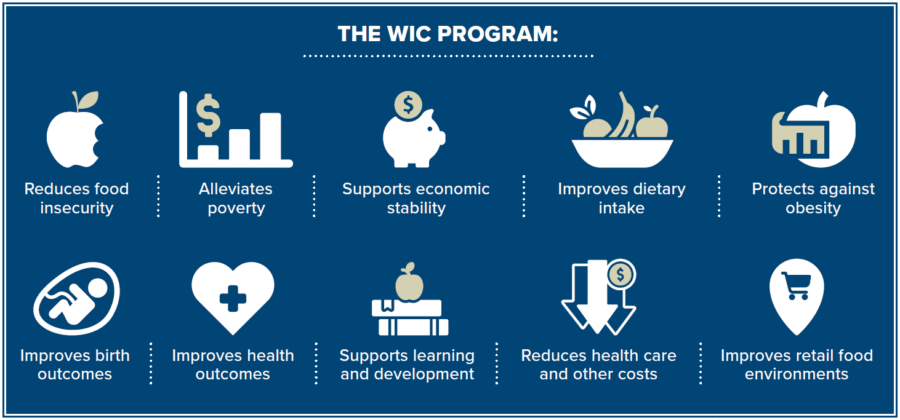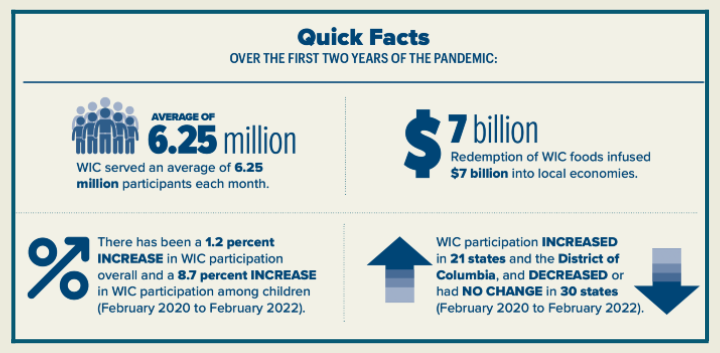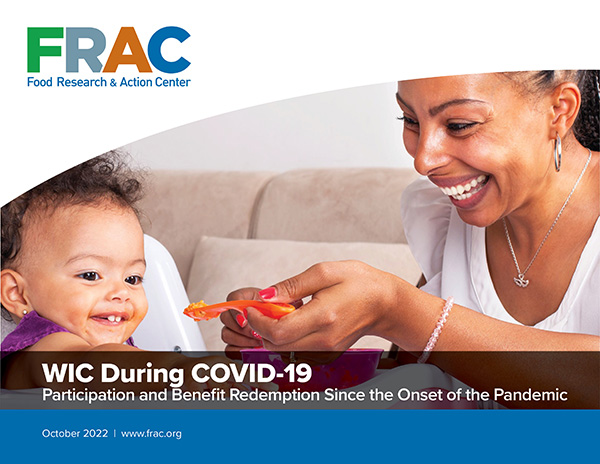More families with young children are taking part in the Special Supplemental Nutrition Program for Women, Infants, and Children (WIC), according to FRAC’s latest report, WIC During COVID-19: Participation and Benefit Redemption Since the Onset of the Pandemic.
Key Findings
-
- Pandemic-related WIC waivers and enhancements have simultaneously removed access barriers and increased the value of participating in WIC, resulting in overall increases in program participation. In February 2022, WIC reached 6.2 million participants, a 1.2 percent increase from February 2020.
- Children make up more than half of all WIC participants with 3.4 million children participating in WIC in February 2022.
- Driven by pandemic-related enhancements to WIC, there was a significant 8.7 percent increase in WIC participation among children from February 2020 to February 2022.
- WIC participation increased in 22 states and the District of Columbia, and decreased or had no change in 29 states (February 2022 compared to February 2020).
- Despite overall modest growth, WIC still reaches too few eligible people.


What Is WIC?
The Special Supplemental Nutrition Program for Women, Infants, and Children (WIC) is a federal nutrition program that provides nutritious foods, nutrition education, breastfeeding support, and health care referrals to nutritionally at-risk infants, children up to 5 years old, and pregnant and postpartum individuals from households with low incomes.
WIC improves participants’ health, dietary intake, and birth and health outcomes. The program also supports learning and development, reduces food insecurity, and helps to alleviate poverty. In addition, WIC supports economic stability and improves the availability of healthy foods in low-income communities through participating stores.
WIC is administered by the U.S. Department of Agriculture (USDA) and is operated by 90 WIC state agencies including 50 state health departments, 33 Tribal organizations, the District of Columbia, and five territories (American Samoa, Guam, Northern Mariana, Puerto Rico, and the Virgin Islands).
WIC During COVID-19: Waivers & Flexibilities
During the COVID-19 pandemic, there are temporary flexibilities and benefit changes being applied to WIC.
WIC waivers have allowed participants to enroll and re-enroll in WIC without visiting a WIC clinic.
WIC agencies also have been allowed to issue benefits remotely, meaning most participants can receive their monthly food package benefits without having to go to WIC clinics.
Through congressional action, WIC’s fruit and vegetable benefit has also been increased to better meet participants’ needs, enhancing the value of the food package overall.

WIC Participation, February 2020–February 2022
Overall, WIC participation has increased 1.2 percent
in the two years since the onset of the pandemic.
| Participant Category | February 2020 | February 2021 | February 2022 | Number Change from 2020 to 2022 | Percentage Change from 2020 to 2022 |
|---|---|---|---|---|---|
| Pregnant and Postpartum Individuals | 1,454,679 | 1,378,160 | 1,376,776 | -77,903 | -5.4% |
| Infants | 1,545,620 | 1,468,867 | 1,425,979 | -119,641 | -7.7% |
| Children | 3,109,510 | 3,412,402 | 3,380,774 | 271,264 | 8.7% |
| TOTAL WIC | 6,109,809 | 6,259,429 | 6,183,529 | 73,720 | 1.2% |
Children & WIC
Children make up more than half of all WIC participants,
with 3.4 million children participating in WIC in February 2022.
This represents an 8.7 percent increase in participation
among children compared to February 2020.
Regional Participation Changes
Regionally, the change in WIC participation from
February 2020 to February 2022 ranged from
an increase of 8.4 percent in the Western region to a
decrease of 8.6 percent in the Mountain Plains region.
| Region | February 2020 | February 2022 | Number Change from 2020 to 2022 | Percentage Change from 2020 to 2022 |
|---|---|---|---|---|
| Mid-Atlantic | 712,787 | 698,619 | -14,168 | -2.0% |
| Midwest | 937,646 | 904,103 | -33,543 | -3.6% |
| Mountain Plains | 308,646 | 282,088 | -26,558 | -8.6% |
| Northeast | 565,307 | 603,729 | 38,422 | 6.8% |
| Southeast | 1,288,273 | 1,328,311 | 40,038 | 3.1% |
| Southwest | 1,146,485 | 1,119,287 | -27,198 | -2.4% |
| Western | 1,150,665 | 1,247,392 | 96,727 | 8.4% |
| ~TOTAL WIC | 6,109,809 | 6,138,529 | 73,720 | 1.2% |
From February 2020 to February 2022, all regions
experienced an increase in WIC participation among children,
except the Mountain Plains region.
Recommendations
With only a modest 1.2 percent increase in WIC participation
from February 2020 to February 2022, more needs to be
done to increase WIC participation and meet the
increased demand prompted by the COVID-19 pandemic,
throughout the economic recovery, and in the future.
Recommendations for Congress
-
- Make permanent the flexibilities enacted during the COVID-19 pandemic that allow for remote enrollment, services, and benefits issuance, and that allow for facilitation of online ordering and payments.
- Fund and permanently increase the value of WIC’s fruit and vegetable benefit to levels recommended by the National Academies of Science, Engineering, and Medicine.
- Provide investments to better coordinate and securely share health and participation data between the health care sector and WIC, particularly between Medicaid, health clinics, and WIC to ensure ability to continue access to remote WIC services.
- Provide funding for infrastructure, technical assistance, electronic benefit transfer technology and management information systems to ensure remote service offerings are successful.


Recommendations for WIC Agencies
-
- Offer the full range of WIC services and benefit issuance options, including maximizing remote access to WIC through phone appointments and remote benefit issuance.
- Maximize partnerships and data sharing with health care providers, Medicaid, and other program operators including Head Start, child care subsidy programs, and SNAP, to streamline processes at WIC clinics, limit unnecessary paperwork, and reduce participant burden.
- Coordinate with community partners to conduct community-centered and innovate WIC outreach. Effective outreach by community partners can broaden the reach of WIC and help overcome barriers to participation, including widespread misconceptions about eligibility, concerns expressed by immigrant families, and limited access to information about WIC benefits, including how to apply.
Stakeholders and Advocates Can Help Strengthen and Expand WIC
Urge Congress to Take Action Through Child Nutrition Reauthorization

Advocates can help expand WIC and reduce barriers by urging their Members of Congress
to pass a robust Child Nutrition Reauthorization package this fall through FRAC’s Action Network tool.
Work with your local or state WIC Agency to conduct community-centered WIC outreach
and refer potentially eligible families to apply for WIC.

Advocates can refer families to apply for WIC through the WIC Agency’s website, calling the toll-free number, or signupwic.com.
The WIC Guide for Health Care Providers can be useful in referring patients to WIC across many types of health care settings.
Communicate with your WIC Agency, urging them to swiftly make
critical improvements needed in WIC.

Critical improvements needed include continuing to offer the full range of WIC services and
benefit issuance options allowed, including maximizing remote access to WIC through phone appointments
and remote benefit issuance. Working with your WIC agency to maximize innovation, partnerships, and data sharing
with Medicaid, Head Start, child care subsidy programs, and the Supplemental Nutrition Assistance Program (SNAP)
can help streamline processes at the WIC clinic, limit unnecessary paperwork, and reduce participant burden.

WIC During COVID-19 Report
Read the report
Communications Toolkit
Spread the word!
Report Finds WIC Enhancements Result in Improved Access and Increased Participation During COVID-19
Read the blog post
WIC Report Press Release
View the release
One Year of WIC During COVID-19
Read the fact sheet
The Benefits of WIC
View the fact sheet

